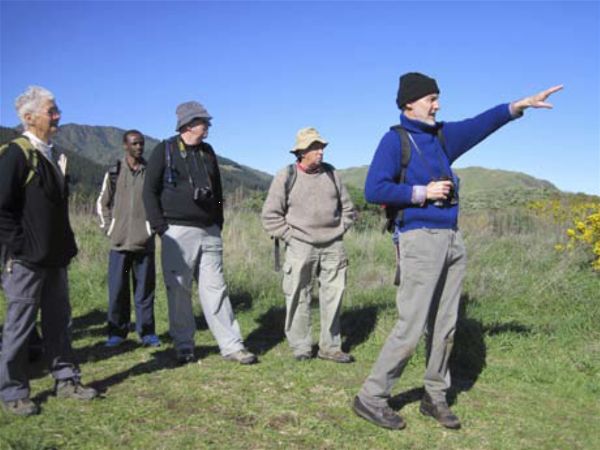Trip Report – 3 July 2010: Dune forest restoration, Queen Elizabeth Park
At 9.30 a.m., 5 hours after a 7.1 earthquake hit Canterbury, we met at MacKays Crossing. Unexpectedly the morning was calm, sunny and mild – paradise!
Our plan was to see how the Friends of Queen Elizabeth Park (QEP) were conserving, restoring and enlarging the remnant of dune-swamp podocarp forest in the park. Originally 1.2ha – the park is 630 ha – this forest patch, with the coastal dunes, streams and riparian strips, and wetland swamps in QEP, is yelling out to be saved.
 |
| Trip leader Robin Fordham points out restoration planting at Queen Elizabeth Park. Photo: Carol West. |
Efforts to conserve the remnant forest, used in WWII by US marines, and damaged by wind, horses and cattle, began in 1990. That group planted anywhere in the tiny patch, aware that the dominant kahikatea, the odd matai, rata and pukatea, and a few swamp maire and milk trees, were significant locally and regionally. Ecologically, dune forest has national significance.
In 2009 the Friends obtained grants from DOC’s Community Conservation Fund. BotSoc supported the applications, totalling $60,000, to help their plan of enlarging the remnant to 12 ha. First, a fence was built to enclose the area and exclude cattle. Then detailed planting plans were prepared, and planting outwards from the remnant began. The plants are eco-sourced, many coming from a large Taupo nursery. Ultimately, the Friends aim towards 20ha or more of forest to provide a decent stepping-stone between the Akatarawa Range and Kapiti Island.
Plants used for dry areas are kanuka, manuka, mahoe, karamu, ngaio; for wet zones are ti kouka, flax, kahikatea, toetoe, manuka, sedges and rushes; for enrichment plantings are totara, akiraho, tarata, wharangi, kohekohe, nikau and kahikatea.
We traversed the recently planted wet areas, then moved into the original remnant. The Friends decided it was crucial to know the age of the stand. A kahikatea cored by Peter van Essen was 92 years old, and on adjacent Whareroa Farm a kahikatea and a totara were 87 and 102 respectively. The core holes were then treated with a pruning fungicide. Photos and land-use history support the view that the remnant arose on land cleared for farming, from the seed bank and / or immigrant seeds. Macrocarpa on the northwest edge of the remnant are 72 years old, and may have been planted for shelter or fuel.
The forest remnant, indeed the whole of QEP, faces threats. These include weeds and mammal pests – both being tackled – and extreme weather events. Other major threats have serious potential effects:
1. A four-lane expressway proposed by NZ Transport Agency would cut c. 60ha off the park, when SH1 can be widened.
2. A farm lessee wants to lower the water-table to get more pasture, which would dry wetlands and the forest.
3. GWRC aims to reduce support and services for QEP - the most visited, most accessible of its regional parks.
4. KCDC plans soccer fields in the park; there is a lobby for a printing-press museum in a large ‘heritage precinct’; a huge whale sculpture is mooted for the QEP dunes; and a new ‘Raumati’ rail station is proposed, all of which would require extensive car parks, shops, buildings and services.
The Friends oppose ‘heritage’ activities with no links to the park, but do support heritage developments to do with Maori, the US marines, farming, and the environment. On top of these specific threats, developers in Kapiti remove c. 60 ha / yr, equivalent to the whole of QEP every 10 years! Progressive loss of QEP public land to sectional interests is the ‘Tragedy of the Commons’ writ large.
Finally we visited the nursery, which can hold 10,000 plants, and in which many plants for the forest remnant are germinated and grown on.Robin Fordham
Along the way we discussed the interesting suite of weeds, including
Lythrum hyssopifolia submerged in the lake now accommodating Canadian geese, etc.
We drove to Whareroa Beach for lunch among marram grass,
Ammophila arenaria, and a range of weeds including ice plant,
Carpobrotus edulis. Some of us then walked along the bank of the estuary of Whareroa Stream. We found some planted
Carex testacaea propagated from a single local plant recorded by Barbara Mitcalfe on a botanical survey in 2000. A small area of
Carex pumila was surviving away from the ubiquitous tall fescue,
Schedonorus phoenix, that dominated the area. Tucked against the banks of the stream within the tidal area was a small clump of
Schoenoplectus tabernaemontani, with its side-mounted inflorescences.
Scattered among the weeds dominating a flood-prone area was also a browned-off sedge that Barbara identified as
Bulboschoenus caldwellii.
Walking back to the car park took us through groves of
Acacia saligna in full flower that, on this rare fine day, provided shade to picnickers.
Mick Parsons
Participants : Dave Awn, Rae Collins, Robin Fordham (leader), Guyo Gufu, Stephen Hartley, Chris Horne, Rodney Lewington, Barbara Mitcalfe, Phil Parnell, Mick Parsons, Darea Sherratt, Carol West.

 Site Index
Site Index







 Site Index
Site Index





